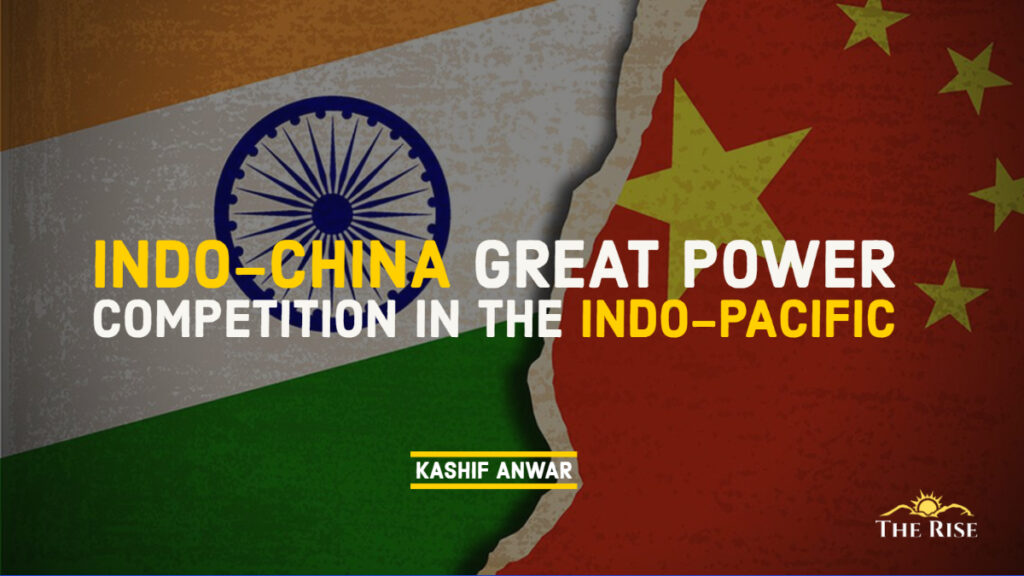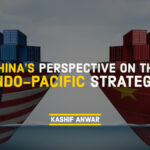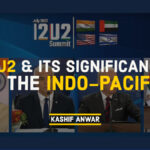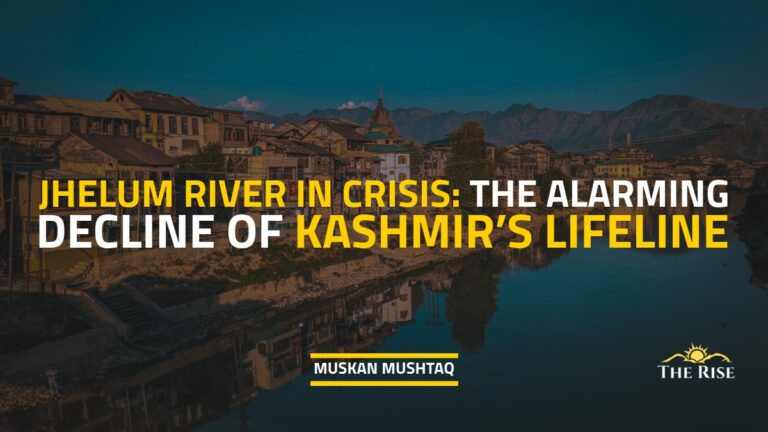With the establishment of the Indo-Pacific concept, the relationship between India and China has taken a drastic turn in their bilateral and multilateral engagement causing constrain in their ties. In such regard, no longer the Indo-China ties could be viewed from a narrow perspective as it has evolved and rather should be viewed from the great power politics. Although, the ambition of China is clearly visible of acquiring more power and enhancing its stature and position in global politics and power vis-à-vis India which has kept a balanced and friendly approach to secure its national and strategic interest ensuring its rise doesn’t alarm others.
The origin of the Indo-Pacific term can be traced to Karl Haushofer’s work, a German geopolitician, ‘German cultural policy in the Indo-Pacific region/Deutsche Kulturpolitik im Indopazifischen Raum’ in 1939 and later in Kalidas Nag’s work in 1941. On the other hand, the Indo-Pacific concept was later coined by the late former Japanese PM Shinzo Abe in 2007, and its subsequent global acceptance changed how the Indian Ocean and the Pacific Ocean Region and its maritime and geography will be looked at.
Although China was comfortable with the Asia-Pacific concept as it referred to a large landmass including oceans, the Indo-Pacific concept focuses more on the maritime aspect of the Indian Ocean and the Pacific Ocean region. The construct of the Indo-Pacific Region not only augmented India’s role, position and engagement in the region but also allowed India to address the challenges it faces in the Indian Ocean Region (IOR) and the threat emanating from China’s rise. With the adoption of the Indo-Pacific vis-à-vis Asia-Pacific by QUAD members followed by the European Union (EU) and ASEAN looking toward the Indo-Pacific region, the concept reflects India will play an important role in Asia in the coming years.
As the development was directed toward securing security, strategic concerns emerged in the region due to China’s rise. China viewed itself as the core of this strategy that is meant to stop or create hindrances to its peaceful development, in their worldview. Wu Shicun, President of the National Institute for South China Sea Studies (NISCSS), Haikou City, China, argues that the US Indo-Pacific strategy is directed against China and is meant to develop an exclusive regional block. Once implemented, he argues, it will challenge BRI and its position in the South China Sea and become a great strategic concern for Beijing.
With the adoption of the Indo-Pacific vis-à-vis Asia-Pacific by QUAD members followed by the European Union (EU) and ASEAN looking toward the Indo-Pacific region, the concept reflects India will play an important role in Asia in the coming years.
Also Read: The Growth Story Of ASEAN Powers: Indonesia and Malaysia
Acceptance of the Indo-Pacific concept highlights that the relationship between great power and their politics will be the prime focus. As ‘Great Power Politics’ refers to the pursuit of material power by powerful states in the international system to achieve security. Meanwhile, John Mearsheimer argues that fear, self-help and power maximisation are essential for a state’s survival. In such regard, the state’s push to acquire more power on land or sea becomes part of its survivability, and thus struggle and dominance for power run in parallels.
Meanwhile, in great power competition, with access to the sea, the state intends to enhance its land and sea power, and history is full of such examples of great power rivalry. As land-sea powers must obey geography’s limits, such powers “shouldn’t neglect sea power or land power to expand its capability”. As Alfred T. Mahan argues, ‘the dual-use and control of the sea are but one link in the chain of exchange by which wealth accumulates’. Mahan stresses sea as the “great highway” or “wide common” of civilisation, naval power – to protect merchant fleets – that had always been the determining factor in international political struggles.
Indo-Pacific Region and Security and Deterrence in Indo-China Relationship
Although the Indo-China relationship dates back to centuries of cultural, religious and economic interaction in modern times, it began in 1949 when ‘Hindi Chini Bhai Bhai’ was used to strengthen their bilateral relationship, which was impacted due to the 1962 war. Despite the war, the Line of Actual Control (LAC) remained stable and peaceful, and Indo-China bilateral relationship has seen great cooperation. Over the years, both countries cooperated on various issues and worked to bolster their cooperation.
However, Shyam Saran, in his book “How China sees India and the World” argue that in 2005, China was ready to make some concessions to India to forestall an incipient of the Indo-US alliance and any anti-China lobby or group. After the 2008 financial crisis, China saw the credibility of the US had eroded, and its will to exercise power has diminished – a power in retreat – and thus saw it will be futile to resist China’s eventual regional and global dominance.
Since 2008 and after BRI’s launch, the Sino-India relationship saw growing great power competition, as China’s global ambition caught India off-guard and further alarmed the Indian government. As a result, the Indo-China ties became a mixture of cooperation and competition with India’s opposition to BRI. India’s tilt towards the West to secure its strategic interest began Sino-India great power competition in the Indo-Pacific region.
Since 2008 and after BRI’s launch, the Sino-India relationship saw growing great power competition, as China’s global ambition caught India off-guard and further alarmed the Indian government.
Also Read: China’s Perspective on the US Indo-Pacific Strategy: A Scholarly View
Meanwhile, Indo-China cooperation and stability at LAC resulted in the establishment of BRICS, the New Development Bank and the Asian Infrastructure Investment Bank, highlighting the scope of more cooperation between India and China. After the 2017 Doklam incident and the recent standoff in the Galwan valley region on May 05, 2020, such developments were a consequence of the clash of India and China’s maritime interests in the Indo-Pacific region. Further, China continued to emphasise ‘Actual’ in LAC to define its relationship with India and reflects well in Sino-India economic trade relationship and how China view India vis-à-vis other power (a retreating image in China’s rear-view mirror).
To strengthen his and CCP’s position in China, in October 2017, Chinese President Xi Jinping promised by the year 2049, China’s PLA will have an expeditionary capacity of global reach. It was followed by an amendment to the Chinese Constitution in 2018, which provided President Xi Jinping with ease to carry forward his ‘Chinese Dream’ project. However, China’s elevated status, accompanied by its incredible progress, has attracted both friendly and hostile gestures, as Global Times argues that ‘“China must ignore the noise of the “Chinese military threat” theory from some Western countries”.
Since 2005, the gap between India and China and their GDP and Military Expenditure have widened by five times and four times, respectively; by 2015, on the other hand, since 2020, the Indo-China trade imbalance has reduced a little. With strained Indo-China ties in the Indo-Pacific region, China, on the other hand, continues to upgrade its infrastructure across LAC, and India continues to maintain the status quo on LAC.
Further, since the Galwan valley incident, Indo-China bilateral relationship has seen tremendous changes, as it has become competitive. As a result, it pushed India closer to the US as drums of war were closely watched-out, compelled India and China to enhance their respective infrastructure across LAC. This situation completely changed LAC’s security picture compared to LOC with Pakistan. Therefore, despite various reasons for the cause of the incident, development in the sea and on land are interconnected and should be looked at to understand the development in Indo-China ties.
As in the past, the maritime domain has played a very important role in establishing new and emerging powers, which shaped the global security structure on various occasions. Today such powers in the Indo-Pacific Region are being viewed to play similar roles in countering the Chinese threat narrative, protecting current global order and structure and further ensuring a free and open Indo-Pacific region. Under the current global situation, the role of India has become important – a neighbour to China – as the Indo-Pacific Region provides New Delhi with a strategic opportunity to further expand its influence in the region and IOR.
The Galwan Valley incident pushed India closer to the US as drums of war were closely watched-out, compelled India and China to enhance their respective infrastructure across LAC. This situation completely changed LAC’s security picture compared to LOC with Pakistan.
Also Read: America is Back – Or is it?
China’s rise hasn’t only pushed India to strengthen its economic and military posture but has become the foremost foreign policy challenge in recent years. With recent advancements that China has made in its naval capabilities and reach in the South China Sea, the East China Sea and the IOR, India has been pushed to further enhance its Naval capabilities in the IOR, commissioned two aircraft and established a fully operational nuclear triad in 2016.
Recent Chinese actions in the Indo-Pacific Region highlight that Deng Xiaoping’s ‘hide its light and bide its time’ has changed to President Xi Jinping’s ‘strive for achievement’ reflected in China’s relationship with the US and India. In the wake of geopolitical change, which recently emerged due to the rise of China, the US dominance in the Indo-Pacific region was affected, pushing the American government to restructure its alliance structure to counter China’s rise under its Indo-Pacific strategy.
China, under the Maritime Silk Road, was able to transit the Indian Ocean and construct civil-military fused ports and bases in Sri Lanka, Pakistan, Djibouti and Cambodia. For India, its interest in IOR and to keep its hold in the region firm and stable, such Chinese-built dual-purpose ports have become a major concern/issue that needs to be addressed. In recent times, China’s rise has shaped India’s approach toward the Indo-Pacific Region to address emerging security threats in the IOR and Southeast Asia. To address such concerns, India strengthened its partnership with other powers and is also working to balance its relationship with the West and emerging geopolitical competition with China.
Recent Chinese actions in the Indo-Pacific Region highlight that Deng Xiaoping’s ‘hide its light and bide its time’ has changed to President Xi Jinping’s ‘strive for achievement’ reflected in China’s relationship with the US and India
With increased China’s influence in South Asia, IOR and the Southeast Asian region, India views it as a new geopolitical challenge in the Indo-Pacific Region, and the region provides India with the theatre of opportunity and ability to address its capability gap with an assist from the West. With strong economic growth and military power, India’s position in IOR and Indo-Pacific strategic theatre has become important in recent years. Furthermore, the Indian government’s strong impulse, especially in recent years to establish comprehensive relations with its neighbour and great power was reflected in its role in QUAD and now in the I2U2.
As the Chinese threat is not new to India, on the other hand, the US intends to secure its power, position, allies and friends in the Indo-Pacific region, which pushed the US to establish and strengthen QUAD, AUKUS, and I2U2 to counter China economically and militarily. China’s rise not only challenged India’s position on the LAC and became a greater threat to India than a few decades ago. As Shyam Saran states, it started to alter the Asian security structure and order, the global balance of power and further undermined global order and the ‘Washington Consensus’.
The expansion of the BRI and ‘win-win cooperation’ attracted many countries to bandwagon China’s economic rise to secure their domestic economic growth and development. However, the current situation in Sri Lanka and Pakistan, along with Kenya, Montenegro, Samoa, Tonga, Angola and Tajikistan, highlights the risk of China’s debt trap diplomacy, providing China to use such a situation to its advantage.
A shift has been seen in India’s foreign policy from its non-alignment to multi-alignment. As it reflects, India’s philosophy of ‘effective multilateralism’ has not only embraced the reality of the rise of many countries; it further recognised the voice of the many and not of the few to determine the global agenda.
Also Read: Pacifism in Words, Militarism in Actions: The Sounding Brass Leaders of 21st Century
Considering India’s geolocation, in recent years, China’s actions have pushed India to adopt a strategic posture to enhance its relationship with the West and its position on the LAC, in the IOR and Indo-Pacific region to counter China’s growing influence. As the IOR is a key route for global trade, including energy supply, Chinese action in the region intends to secure its sea lanes and lines of communication (economically and militarily) with the IOR islands countries could prove pivotal to the Chinese navy in the future, as visible in the case of Djibouti.
As the Indian government view the Indo-Pacific region as a key strategic and economic theatre. China intends to undo India’s naval advantage, and the recent visit by China’s Yuan Wang 5 to Sri Lanka further alarmed India. With IOR being relevant for China, it didn’t intend to give up its two-ocean strategy. Thus India should deepen its ties with the IOR island countries in economic and financial terms and keep a watch on the domestic narrative in these countries towards India (like the India Out campaign in the Maldives).
In such a situation, it alerts and puts pressure on India in the IOR; as C Raja Mohan argues, India should focus on its strength in the IOR instead of denying China a strategic hold in the region. Unlike QUAD and I2U2, the AUKUS, a military alliance, has allowed the US to reposition itself to counter China. Although India welcomed the move, kept a neutral stance, and welcomed the involvement of the UK in the Indo-Pacific Region. Recently, a shift has been seen in India’s foreign policy from its non-alignment to multi-alignment. As it reflects, India’s philosophy of ‘effective multilateralism’ hasn’t only embraced the reality of the rise of many countries; it further recognised the voice of the many and not of the few to determine the global agenda.
Although India’s relationship with China after 2014 was marked by cooperation and competition, after the Galwan Valley incident, the rivalry between India and China stretched from the LAC to IOR to Indo-Pacific Region. Under the Indo-Pacific concept, the IOR remain an area of interest worldwide and important for the global economy and oil transit. Meanwhile, as many argue, India’s low military budget vis-à-vis China, and India’s partnership with QUAD, based on flexibility and not an alliance system, has impacted India’s strategy to counter China.
On the bonhomie between the US and India, Dr Hu Shisheng, Director at China Institutes of Contemporary International Relations (CICIR), argues that India, to compete with China and to cater for its needs India is working with the US. Further, as the Indo-Pacific strategy focuses on how to counter BRI, Hu states that India’s stand on the BRI reflects New Delhi’s acceptance of the US Indo-Pacific Region Strategy as India intends to counter Chinese influence in the region. Hu argues India as an individual lacks strength, and thus it cannot irritate China immeasurably as India lacks sufficient national power.
It became evident another Galwan valley incident would further push India closer to the US, which would undermine China’s Major Power Diplomacy and Neighbourhood Strategy – under BRI. On the other hand, as the incident strengthened QUAD, Indo-US ties formed I2U2, pushed the West’s role in the Indo-Pacific region and addressed India’s capability gaps in the IOR. In this regard, how China view India, many Chinese scholars and strategists, including Zhen Yongnian, Sun Xingjie, Ling Shengli, and Feng Chuanlu argue China should rather equate the Beijing-Washington relationship and the Beijing-New Delhi relationship. As they stress, it will be better for China, as close Indo-US economic ties, especially under the Indo-Pacific Economic Forum, will only hamper China’s industrial supply chain and economy. Thus, development at the LAC should be normalised with peace and more area of cooperation to be explored between India and China.
Being a democracy, India is also using the civilisational and cultural link to strengthen its ties with countries in the Indo-Pacific region through its Act East Policy (aligned with South Korea’s New Southern Policy), the Neighbourhood First Policy and the SAGAR concept.
You May Like: A Rundown of Sports Diplomacy
Such views were reflected when the issue of Galwan Valley was deliberately played down in China, as Ye Hailin, Zhang Jiadong, Hu Shisheng, and Lou Chunhoa argue that a new model of China-India ties to re-consider with India neither a friend nor foe of China. Such a statement illustrates not only cooperation between India and China to remain unaffected but also shows China has accepted the current established geopolitical development, structure and order in the Indo-Pacific Region, and China is working hard to ensure its rise remains unhindered. As China continued to increase its influence and reach in the IOR and the Pacific Ocean Region within its two-ocean strategy and was visible in recent outreach to the Pacific Islands countries and influence in Mauritius, Maldives, Sri Lanka, Madagascar and Nigeria under BRI.
Meanwhile, PM Modi’s emphasis on maintaining economic ties with China vis-à-vis current infrastructure build-up at the LAC shouldn’t be seen as India’s eagerness to cooperate with China ignoring its strategic interest. India has intensified its Aatmanirbhar Bharat programme and engaged deeply with West and Southeast Asia, and East Asian countries to reduce its reliance on China and strengthen itself economically. As I2U2 improved India’s position in West Asia, the launch of the Indo-Pacific Economic Forum under QUAD provided India with a valuable economic opportunity to tap.
Although, the magnitude and momentum China enjoys (economic and military size) to achieve its dominance in the Indo-Pacific Region, which India lacks. Being a democracy, India is also using the civilisational and cultural link to strengthen its ties with countries in the Indo-Pacific region. With the strengthening of the Indo-US strategic partnership, India, through its Act East Policy (aligned with South Korea’s New Southern Policy), the Neighbourhood First Policy and the Security and Growth for All in the Region (SAGAR), India was able to engage deeply with South Asian, Southeast Asian and East Asian countries. In recent years India emerged as an active and willing player and a responsible actor, its multi-dimensional engagement with QUAD members and the ASEAN made India a direct stakeholder in initiating dialogues and created a balanced security architecture to address its non-traditional and traditional security issues.
Conclusion
For a long time, India kept a safe distance and maintained cordial relations with countries worldwide. However, the construct of the Indo-Pacific concept and the Chinese threat pushed India to act as a responsible power and player on a global stage. India’s Indo-Pacific Strategy is based on inclusiveness, openness and ASEAN centrality to address India’s strategic concerns. The growing importance of the Indian Ocean and Pacific Ocean today has brought the construct of the Indo-Pacific to the centre of global political discourse. It is evident from China’s actions and behaviour that it adopted a non-accommodative stance toward India’s concerns, from border disputes to its strategic interest in the IOR and the Indo-Pacific region. However, India has enhanced its military posture and relationship with the US, the West and like-minded countries under QUAD and the I2U2 to secure its geo-strategic and geo-economics interest vis-à-vis balancing its ties with China in the Indo-Pacific region.
As cooperation and competition highlight the Indo-China relationship, India’s closeness to the West and the involvement of the European Union, the UK and France in the Indo-Pacific region have alarmed China. In the coming years, with the return of great power rivalry and the re-emergence of bloc politics, India has increased its engagement at the bilateral and multilateral level and has become a vital regional power and responsible player to ensure the Indo-Pacific region remains free and open. Today, given the Chinese aggression along LAC and in IOR, India has further redefined its priorities under the Indo-Pacific strategy. From trade and technology to regional and global collaborations, India’s foreign policy and security narrative is designed to secure its interest and tackle China’s challenge at LAC, IOR, and Indo-Pacific region. Such a broad shift in India’s stance in the Indo-Pacific region will have a significant bearing on its future trajectory and its relationship with China, transforming the Indo-China relationship.
Disclaimer: The views expressed in this article are of the author solely. TheRise.co.in neither endorses nor is responsible for them. Reproducing this content without permission is prohibited.
About the author
Kashif Anwar, is a Research Associate at the Centre for Air Power Studies (CAPS), New Delhi, has an M.Phil in International Studies. His area of research interests is China, the US, India, geo-strategy, geo-economic, military technology, and geopolitical developments in the Indo-Pacific region. He has presented research paper at Jamia Millia Islamia and the Christ (Deemed to be University) Delhi NCR and published his papers in the Geopolitics, Financial Express, the Defence Horizon Journal and TheRise.










